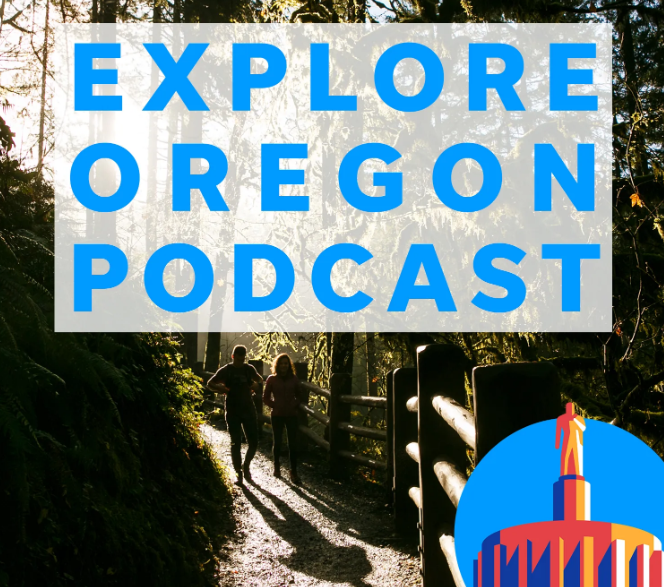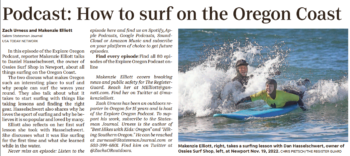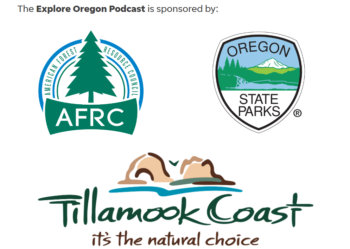How the Statesman Journal expanded its audience through a podcast focused on the Oregon outdoors
Zach Urness and Cherrill Crosby, Statesman Journal,
The Statesman Journal uses this promotional image in digital articles to announce new episodes of the Explore Oregon podcast.
Here’s an idea to steal and adapt: If you have the expertise to cover a topic with a robust audience, consider moving beyond a “destination website,” app or videos, and try producing a podcast on that topic. And give the podcast time to grow its audience.This is a series on Better News to a) showcase innovative/experimental ideas that emerge from the Knight-Lenfest Newsroom Initiative and b) share replicable tactics that benefit the news industry as a whole. This “win” comes from Zach Urness, outdoors editor, and Cherrill Crosby, executive editor, both of the Statesman Journal in Salem, Oregon. The Statesman Journal participated in the Poynter Table Stakes program 2017-2018.
Question: What communities do you serve and what can you tell us about the history of your organization?
Answer: We serve Salem and Eugene, Ore., through the Statesman Journal and The Register Guard newspapers and associated websites StatesmanJournal.com and RegisterGuard.com. In the outdoors department, we have traditionally covered most of Oregon’s outdoors both for news and travel features. Our podcast has found an audience primarily in the Pacific Northwest, from southern Oregon to Seattle.
Q: What problem were you trying to solve, and why was solving the problem strategically important for your organization?
A: We’d had a lot of success finding a large and devoted audience for our Oregon outdoors content, which at that time consisted of travel features, photo galleries, news coverage and list-style stories (10 best hikes near Portland).
Oregon is a place where the outdoors is front and center — where probably more than 80% of the population does some type of outdoor activity, whether it’s hiking or camping, fishing or hunting, skiing or snowshoeing, or surfing or mushroom hunting.
We had a good audience, a good opportunity and expertise in the topic. The problem had been turning that into revenue beyond digital subscriptions and pageviews. We’d tried a variety of things like a ”destination website,” an app and high-quality videos. None really worked the way we had hoped.
Q: How is this approach related to Table Stakes (e.g. one of the 7 Table Stakes and/or an outgrowth of the Knight-Lenfest initiative, etc.)?
A: This initiative relates directly to Table Stake No. 1 (“Serve targeted audiences with targeted content”) and Table Stake No. 2 (“Publish on the platforms used by your targeted audiences.”)
Specifically, we wanted to see if there were ways to grow our audience and increase our brand by enhancing our outdoors coverage. We arrived at a podcast because it is available/convenient whenever and pretty much everywhere people want to listen. We were confident in our expertise and that we offered high quality content. The real challenge was how to make money and keep consistently providing the content we already offered while taking on a podcast.
Q: How did you go about solving the problem?
A: At our initial meeting in the newsroom, in spring of 2018, three ideas were presented: a video series showing outdoor adventures; a series of classes taught by our outdoors writers and photographers; or a podcast.
We had tried all three to varying degrees of success. Videos and classes had merit, but what we ultimately found was that they were incredibly time consuming, leaving far less time for normal, day-to-day reporting.
A podcast was, simply put, easier to pull off, but still allowed us to hit all our sweet spots. We also felt podcast popularity was on the rise (it was) and that there was a willingness from potential sponsors to try it out as an alternative to classic modes of advertisement.
We decided that it would take the elements of our reporting that worked well and come up with a format that listeners would come to find familiar. Mainly, we decided to focus on well-loved outdoor destinations and add elements like news reporting, historical research and expert guests to bring it to life.

An article in print promotes to the Explore Oregon podcast.
Even so, it took a few months to actually launch Explore Oregon, in part because we decided to work out all the bugs and record the first four episodes before launching them all at once, like the season of a new show, so the audience has more than just one piece to dig into.
We launched the podcast in summer of 2018. That first partial year, we saw just 3,400 plays. The year after, we more than quadrupled the number of plays, followed by a doubling of plays in 2020, and more than 90,000 plays in 2021. This year, we have surpassed 140,000 plays.
At the end of 2018, we had nine episodes available. There will be 90 episodes of the Explore Oregon podcast available by the end of this year.
Learn more about growing revenue with content verticals: Religious content | Sports content | Black audiences
Q: What worked and who from your organization was involved?
A: The project was undertaken by outdoors reporter Zach Urness and news producer David Davis, two longtime friends who both enjoyed the outdoors and knew the state.
Zach did most of the writing and came up with the episodes, while David focused on the technical aspects such as quality sound, microphones, platforms and various things on that end. But both had voices on the podcast and brought their own unique experiences and reporting to the process.
What worked was creating episodes that were evergreen. Meaning, you could listen to the very first episode about Silver Falls State Park the moment it was released, or five years after it was released, and it would still hold up.
The big idea was to create a catalog of high-quality episodes people could browse through and listen to regardless of when they found or needed it. We believed that the better weather months would be the most popular — they are — but that people would listen during the rainy season and winter, too, as an aspiration to get outside or plan a trip to Oregon.
The other thing that worked was deciding to go with fewer high-quality episodes, as opposed to more lower-quality episodes.
Early on, writing and recording and editing the podcasts took forever because we wanted to get it right, based on the idea that if something is just so-so, people are unlikely to come back. We also were new at it. After doing dozens of episodes, our speed to plan, direct and produce has increased.
Today the podcast averages about 15,000 unique plays/listens per month (the number of people who listen to the catalog of episodes total). There are three sponsors at different tiers who currently combine to pay enough that we can hire three outdoors journalism interns per year (10 weeks each at 40 hours a week), to help out with the podcast and outdoors reporting.
Getting the sponsors was an interesting journey. One mistake smaller podcasts make is to target giant brands like REI and Patagonia who want to do advertising on a mass scale. A smaller and local podcast like ours doesn’t really appeal to them because we’re not reaching millions of listeners. We ultimately targeted sponsors who already were engaged with our content — who were familiar with Zach’s reporting — and were likely to want to reach our very targeted audience.
For example, one of our sponsors is a tourism bureau on the Oregon Coast that wants to bring people to their area but also give them messaging about safety and stewardship. Our podcast is a great way to reach those types of people directly because just about every listener is likely to travel to the Coast multiple times during a given year. So it was really those two elements: people familiar with our content with an obvious reason to want to reach our audience.

The Statesman Journal promotes the sponsors of the podcast during the podcast and in digital and print text articles.
The last two elements were tailoring a price point that was affordable for them — we have higher and lower tiers of sponsorship — and telling them how their money would be used. The fact that we use the money to hire interns to do journalism is appealing to sponsors. They see their money as going toward a good cause, rather than a corporate bottom line.
David left the Statesman Journal this past spring, leaving Zach in charge of all aspects of the podcast, from writing to editing to creating messages for our sponsors. There are no plans to find a new producer.
Q: What didn’t work?
A: Nobody listened at first. Really for the first couple of years, the podcast got pretty poor listener numbers and was the reason the original potential sponsor passed. That’s because it’s hard to find an audience for a new podcast, even if it’s produced by a local media company.
You have to earn the audience, and hit your head against a brick wall for a long time. We kept going because we believed it in and were getting good reviews. We knew people that did listen liked the podcast and that if we could slowly build an audience it would have staying power.
Q: How did you go about ‘earning the audience’?
A: One plan that worked remarkably well was to have podcast guests that already had their own audience. We targeted a few outdoor photographers and guidebook authors that fit the mold of the podcast but also had a large social media following.
After the podcast would publish, they shared the episode with their audience, which seemed to bring in a new wave of listeners who would stick with it even into different episodes.
For example, we did an episode with a guidebook author from a large environmental group — and ended up picking up a few hundred new podcast subscribers who’ve stayed with us.
Other ways were doing special episodes on newsier topics that still fit the mold of the podcast. For example, we did a two-part series on a controversial wilderness permit system that brought in people who were highly-engaged in our news coverage of it, but may not have listened otherwise. Other ways of grabbing new listeners included posting in relevant Facebook groups, posting links to podcasts in high-performing digital stories and including them in newsletters. At one point, a college professor at the University of Oregon had his students listen to a few episodes for an assignment.
The lesson was just to find random, creative ways to pick up new listeners here and there, no matter how small, because often, they’ll stay with you and it becomes like a snowball that grows ever larger.
Q: What happened that you didn’t expect?
During the pandemic, we went remote like everyone else. Some of the new podcast recording platforms that were developed during the pandemic are so good and easy to use that Zach has stopped using the office studio and just records from a home office surrounded by blankets and pillows. At this point, 100% of the podcast interviews are remote. When it started, all episodes and interviews were conducted in the studio. This has made it much easier to have guests and so we’ve ended up doing more interviews with outside sources than we’d previously planned.
Q: What would you do differently now? What did you learn?
A: Don’t be afraid to just script out episodes. Early on, we thought that to keep it conversational, we should just make an outline and try to have a conversation about the topics.
Many popular podcasters — especially celebrities or well-known personalities — have a very conversational or off-the-cuff speaking style that many podcasters try to emulate. But this just didn’t work because we’d frequently forget important points, or lose our train of thought, or kind of ramble.
Podcasting is really hard. So eventually Zach wrote out the bulk of the episodes. At first we did sound a little scripted but it was still better and eventually we improved at reading the script in a conversational way, and then bouncing off it from time to time. It kept the podcast tight and it was just stronger. So, don’t be afraid to script out podcasts, even if it’s meant to be conversational.
Q: What advice would you give to others who want to launch a successful podcast that generates revenue?
A: Come up with a solid plan and consider making a couple of demo podcasts with pseudo sponsorship positions to make pitches to potential sponsors.
When targeting potential sponsors, think who wants to diversify their audience or target the people you anticipate will be listening.
Be straightforward about how you will spend the sponsorship money. For every $6,000 we raise, we hire journalism students or recent graduates to work 40 hours a week for 10 weeks as interns. If they have podcast experience they help with that, but they also do outdoor excursion stories and cover breaking news on the beat such as wildfires so Zach can keep working on podcasts. In 2023, we will have three interns.
Agree to send the sponsor periodic reports. We do quarterly notes with the number of listeners for the quarter, the trend or how that compares to previous quarters, most popular episodes, where listeners are coming from, etc.
Q: Is there anything else you’d like to add?
A: The trick here was just making sure the episodes were good and sticking with it even when nobody was listening. That’s easier said than done. It took a lot of time away from reporting. It still does. A podcast is almost a full-time job in itself. But you really have to focus on it, or you’ll never succeed. There are a lot of really bad podcasts out there, and you want to rise above those and be rewarded with strong and growing listenership.